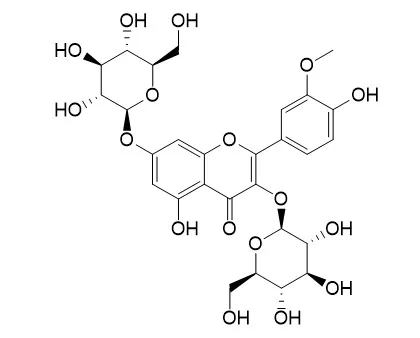| Structure Identification: |
| Rapid Commun Mass Spectrom. 2010 Jul 30;24(14):2009-22. | | Identification of complex, naturally occurring flavonoid glycosides in kale (Brassica oleracea var. sabellica) by high-performance liquid chromatography diode-array detection/electrospray ionization multi-stage mass spectrometry.[Pubmed: 20552580] | The phenolic compounds and organic acids of turnip (Brassica rapa var. rapa L.) edible parts (leaves and stems, flower buds and roots) were determined by HPLC–DAD and HPLC–UV, respectively.
METHODS AND RESULTS:
The results revealed a profile composed of 14 phenolics (3-p-coumaroylquinic, caffeic, ferulic and sinapic acids, kaempferol 3-O-sophoroside-7-O-glucoside, kaempferol 3-O-sophoroside-7-O-sophoroside, kaempferol 3-O-(feruloyl/caffeoyl)-sophoroside-7-O-glucoside, kaempferol 3,7-O-diglucoside,
Isorhamnetin 3,7-O-diglucoside, kaempferol 3-O-sophoroside, 1,2-disinapoylgentiobiose, 1,2′-disinapoyl-2-feruloylgentiobiose, kaempferol 3-O-glucoside and isorhamnetin 3-O-glucoside) and six organic acids (aconitic, citric, ketoglutaric, malic, shikimic and fumaric acids).
CONCLUSIONS:
The quantification of the identified compounds showed kaempferol 3-O-sophoroside-7-O-glucoside, kaempferol 3-O-(feruloyl/caffeoyl)-sophoroside-7-O-glucoside, Isorhamnetin 3,7-O-diglucoside and isorhamnetin 3-O-glucoside as the main phenolics, and malic acid as the organic acid present in highest amounts. A screening of the antioxidative potential was also performed by means of the DPPH radical scavenging assay. Turnip flower buds exhibited the strongest antioxidant capacity. |
|






 Cell. 2018 Jan 11;172(1-2):249-261.e12. doi: 10.1016/j.cell.2017.12.019.IF=36.216(2019)
Cell. 2018 Jan 11;172(1-2):249-261.e12. doi: 10.1016/j.cell.2017.12.019.IF=36.216(2019) Cell Metab. 2020 Mar 3;31(3):534-548.e5. doi: 10.1016/j.cmet.2020.01.002.IF=22.415(2019)
Cell Metab. 2020 Mar 3;31(3):534-548.e5. doi: 10.1016/j.cmet.2020.01.002.IF=22.415(2019) Mol Cell. 2017 Nov 16;68(4):673-685.e6. doi: 10.1016/j.molcel.2017.10.022.IF=14.548(2019)
Mol Cell. 2017 Nov 16;68(4):673-685.e6. doi: 10.1016/j.molcel.2017.10.022.IF=14.548(2019)